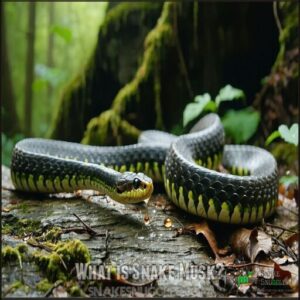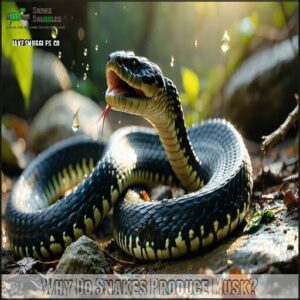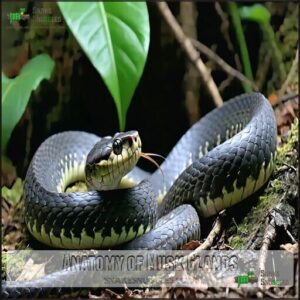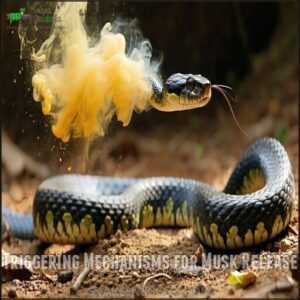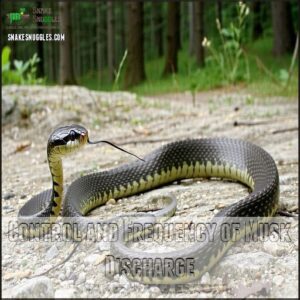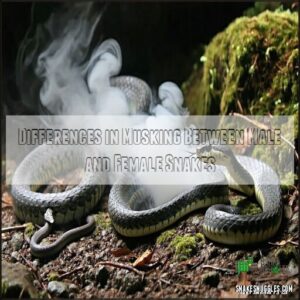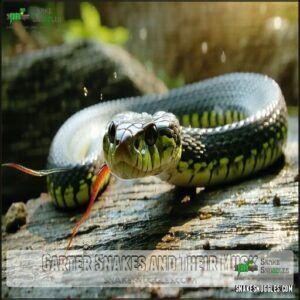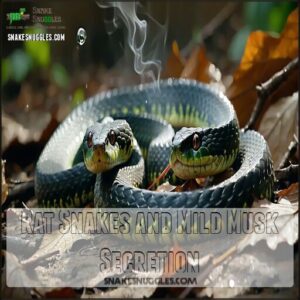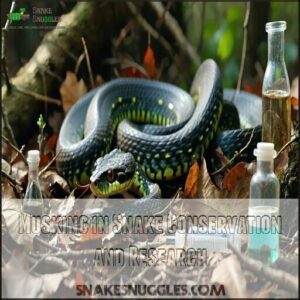This site is supported by our readers. We may earn a commission, at no cost to you, if you purchase through links.
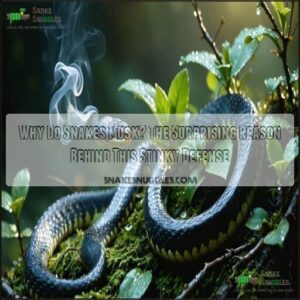
This defense mechanism kicks in when they’re stressed, frightened, or handling feels threatening.
You’ll recognize the distinct, musky odor that can cling to your hands for hours (soap doesn’t always cut it, as many snake owners learn the hard way).
While all snakes can musk, some species like garter and water snakes are notorious stink-bombers.
Understanding why snakes musk helps you read their body language better and adjust your handling technique to keep both of you more comfortable.
Table Of Contents
Key Takeaways
- When your snake musks, it’s releasing a foul-smelling liquid from specialized glands near its tail as a defensive mechanism when it feels stressed or threatened.
- You’ll find that different snake species have varying musking tendencies—garter snakes and water snakes are notorious "stink-bombers," while pythons and boas rarely musk.
- You can’t completely prevent musking, but you’ll reduce its frequency by improving your handling technique and minimizing stress for your snake.
- You’ll need patience when cleaning snake musk from your skin—regular soap often isn’t enough, but dish soap or enzymatic cleaners will help remove the stubborn odor.
What is Snake Musk?
Snake musk is a smelly, oily substance that snakes release from glands near their tails when they feel threatened.
It’s packed with chemicals like fatty acids and sulfur compounds, giving it a stink that’s hard to forget.
Chemical Composition of Snake Musk
Snake musk is a potent blend of volatile compounds and chemical signals designed to repel predators.
Its musk composition includes:
- Volatile organic compounds like acetic and butanoic acids, which spread foul odors quickly.
- Sulfur compounds, responsible for the rotten-egg stench that makes you want to hold your breath.
- Fatty acids, adding stickiness and ensuring the musk lingers long after its release.
- Musk proteins and nitrogen-based compounds, enhancing its potency.
This oily secretion is nature’s ultimate stink bomb, proving that sometimes, being smelly is the best defense strategy snakes have!
Researchers study chemical alarm cues to understand the role of musk in snake defense mechanisms.
Glands Responsible for Musk Production
Tucked near a snake’s tail, cloacal glands are the masterminds behind musk secretion.
These specialized glands, located by the cloaca, work like nature’s stink factories, producing a potent defense mechanism.
Their gland structure efficiently combines chemicals into a foul-smelling mix, ensuring predators think twice.
The cloacal function isn’t just for waste—it’s also a survival tool.
When threatened, these glands release the oily, pungent musk composition, making a snake’s enemies regret their choices!
Variations in Musk Across Snake Species
Not all reptile musk smells alike—think of it as nature’s own stinky signature.
Each snake species brings its own twist to the musking behavior:
- Water snakes: Their musk is a pungent powerhouse, enough to make you gag.
- Rat snakes: Milder, but still far from pleasant.
- Garter snakes: Frequent muskers with a sharp, lingering odor.
- Pythons and boas: Rarely musk, and when they do, it’s surprisingly tame.
This musk variability keeps predators second-guessing!
Physical Properties of Snake Musk
In terms of musk composition, this secretion is a sticky, oily cocktail packed with sulfur compounds, fatty acids, and volatile organic compounds.
Its acidic properties, combined with its oily texture, make it cling stubbornly to surfaces, almost like nature’s glue.
The musk smell? Think rotten eggs mixed with skunk.
Musk glands near the snake’s tail churn out this potent mix, designed to scream “back off!”
Its sulfur content and fatty acids make the scent linger, making it tough to ignore—or wash off.
Why Do Snakes Produce Musk?
Snakes produce musk as a survival tool, releasing it to ward off predators with its overpowering stench.
They also use it for marking territory, communicating with other snakes, and even attracting mates.
Defensive Mechanism Against Predators
When danger strikes, snake musk becomes the ultimate reptile defense mechanism. This foul-smelling secretion acts like nature’s stink bomb, giving snakes a chance to escape unscathed. The snake musk smell is so overpowering it sends predators packing.
Here’s how this clever defense mechanism works:
- Predator Deterrent: The stench overwhelms predators, from birds to mammals, disrupting their focus.
- Threat Response: It’s a bold warning—“Stay away, or regret it!”
- Survival Tactics: By musking, snakes create a smelly diversion, buying time to flee.
It’s a smelly but effective attack prevention strategy!
Territorial Marking and Communication
Snake musk isn’t just a stinky defense—it’s a form of snake language. Through chemical cues, snakes use musk for territorial marking and social communication. Think of it as their version of a “Keep Out” sign or a friendly (or not-so-friendly) note.
- Territorial Scent: Musk marks boundaries, warning intruders.
- Social Communication: It conveys messages like “back off” or “I’m here.”
- Pheromones: Unique to each species, aiding recognition.
- Social Hierarchy: Establishes dominance without conflict.
Snake pheromones keep their world organized and connected! The unique properties of snake musk are related to animalic scent compounds.
Role in Mating and Reproduction
Snake musking behavior isn’t just about defense—it’s also nature’s matchmaking tool.
During mating, musk doubles as a pheromone cocktail, broadcasting reproductive cues to attract potential mates.
This potent mix of pheromones and chemical signals acts like a “love letter,” guiding courtship behaviors and sparking sexual attraction.
In some species, musk even fuels territorial marking, ensuring successful mating competition and reproduction.
The complex process of snake mating involves snake courtship rituals that are essential for successful reproduction.
Evolution of Musking Behavior
Nature’s stink bomb, snake musk, didn’t just happen by chance—it’s an evolutionary adaptation perfected over time.
Musk origins trace back to the constant predator-prey dynamics, where survival meant outsmarting enemies. Snakes with stinkier musk thrived, passing on their genes. This snake musking behavior showcases how evolutionary pressures shaped their defensive strategies.
- Predator deterrent: The foul odor overwhelms attackers, buying time to escape.
- Chemical signaling: Musk may communicate territory or attract mates, proving its versatility.
- Species variation: Some snakes, like garter snakes, rely heavily on musk, while others, like boas, rarely use it.
It’s survival, one stink at a time!
How Do Snakes Release Musk?
When a snake feels threatened, it releases musk from specialized glands near its cloaca, located at the base of its tail.
This milky, foul-smelling substance is discharged as a quick, stinky warning to potential predators, and can be considered a quick warning.
Anatomy of Musk Glands
If you’ve ever wondered how snakes create their infamous stink, it all starts with their specialized musk glands.
These glands, located near the cloaca—the snake’s all-purpose exit for waste and reproduction—are like nature’s version of a stink bomb factory.
In terms of musk secretion, the gland structure varies by species, which explains the differences in scent production and musk composition.
Here’s a quick breakdown:
| Snake Species | Gland Location | Gland Structure |
|---|---|---|
| Garter Snake | Near cloaca, under tail | Simple tubular gland |
| Water Snake | Tail region | Paired sac-like glands |
| Rat Snake | Cloacal area | Complex gland network |
| Milk Snake | Near cloaca | Compact gland structure |
| Copperhead | Close to tail | Dense, sac-like glands |
These glands churn out a milky, oily musk designed to overwhelm predators.
Their unique placement and structure guarantee the snake’s defense mechanism is always ready to go.
Triggering Mechanisms for Musk Release
When a snake senses trouble, it doesn’t waste time with pleasantries—it goes straight for its stinkiest defense.
Snake musk release kicks in when stress levels spike, often triggered by predator presence or physical pressure. Their incredible ability to detect vibrations means even your footsteps can set off this defense mechanism.
If a snake feels a perceived threat, it’ll assume a defensive posture and let its musking behavior do the talking (or stinking).
Handling stress, like being picked up or restrained, is another surefire way to activate their cloacal glands. Think of it as their version of a panic button.
- Imagine this:
- A predator’s surprise dinner plans ruined.
- A handler gagging mid-capture.
- A skunk-level stink bomb deployed.
- A predator’s quick retreat, mission aborted.
Control and Frequency of Musk Discharge
In regards to musk release, snakes are masters of control.
Their cloacal glands, located near the tail, act like a built-in defense system with a "stink switch."
These glands store the musk, waiting for the right moment to release it.
But snakes don’t just spray musk randomly—they’re strategic about it.
Picture this: a predator like a hawk swoops in, and the snake needs to act fast.
It sends a signal to its cloacal gland, deciding how much musk to release based on the threat level.
This precise musk control helps conserve energy and resources while maximizing impact.
Here’s how musking behavior typically unfolds:
- Threat detected: The snake senses danger, like a curious raccoon.
- Signal sent: Snake signals the gland to prepare for musk secretion.
- Musk discharged: A burst of musk defense overwhelms the predator’s senses.
This clever system makes musk secretion efficient and effective.
Differences in Musking Between Male and Female Snakes
In the context of musk variation, male and female snakes don’t always play by the same rules.
Female garter snakes, for example, often release a stronger musk secretion, especially during pregnancy when fleeing isn’t an option.
This gender musking difference likely boosts survival.
However, musking differences depend on the species, so not every snake follows this pattern.
Their musk glands truly keep things interesting!
The unique properties of snake musk make it a valuable component in traditional medicine practices.
Which Snake Species Are Known for Musking?
You’ll find that some snake species are more notorious for musking than others.
Garter snakes, water snakes, and rat snakes top the list, each with their own unique musk strength and frequency.
Garter Snakes and Their Musk
Garter snakes are small but mighty in terms of their musk defense. Their musk glands release a pungent, oily secretion that’ll make you wrinkle your nose.
Female garter snakes, especially when pregnant, often produce a stronger scent—likely because they can’t slither away as quickly.
This snake musk, part of their reptile scent arsenal, is a mix of fatty acids and sulfur compounds. Encountering garter snake musk is unforgettable, but soap and patience can help with musk removal.
Water Snakes and Potent Musk Production
Water snakes are masters of the potent musk defense, producing a strong, unmistakable snake musk smell when they feel threatened.
Their musk glands work overtime, ensuring predators think twice before attacking. If you’ve ever caught a whiff of something foul near a pond or river, chances are it’s a water snake’s musk emission.
Here’s a closer look at some water snakes with a knack for musk:
- Nerodia species: Plainbelly and midland water snakes are notorious for their prolific, pungent musk composition.
- Cottonmouths: These venomous reptiles add a malodorous twist to their already intimidating reputation.
- Northern water snakes: Known for their copious reptile scent, they’re common culprits in aquatic areas.
- Garter snakes: While not exclusive to water, larger ones near streams can rival their aquatic cousins in musk production.
Brace yourself—these snakes don’t hold back!
Rat Snakes and Mild Musk Secretion
Rat snakes, unlike their more odorous relatives, are known for their mild musk secretion. Their musk is often so faint it’s barely noticeable—think of it as the snake equivalent of a polite cough instead of a full-blown skunk spray.
This subtle snake defense comes from their musk gland near the cloaca, releasing a light, oily substance when they feel threatened. While not as pungent as water snakes, individual rat snakes can surprise you with a stronger whiff depending on their temperament or stress levels.
Here’s how they compare to others:
| Snake Type | Musk Intensity |
|---|---|
| Water Snakes | Strong and potent |
| Rat Snakes | Mild and faint |
| Garter Snakes | Moderate to strong |
| Milk Snakes | Noticeable but mild |
| Copperheads | Strong and sharp |
Mild or not, rat snake musk still plays its part in keeping predators at bay, and their unique defense mechanism is based on their musk gland, which releases a light, oily substance when threatened, making their musk secretion a key factor in their survival, and highlighting the importance of understanding their subtle snake defense.
Comparative Analysis of Musk Across Snake Families
Each snake family has its own signature musk, creating a stinky "family trait" that’s hard to miss.
- Garter snake musk: Surprisingly potent, especially in younger snakes.
- Water snake musk: Think fish market—oily and overwhelmingly pungent.
- Rat snake musk: Milder, but still enough to wrinkle your nose.
- Kingsnake musk: Strong and distinct, leaving no doubt who’s in charge.
- Python musk: Rarely produced, but when it is, it’s unforgettable.
Snake musk defense varies widely, with musk glands adapted to each species’ needs. Whether mild or nose-burning, these reptile pheromones guarantee survival.
Effects of Snake Musk on Predators
When a snake releases musk, it’s like setting off an olfactory alarm that predators can’t ignore.
The foul smell overwhelms their senses, often making them think twice about sticking around for a meal.
Olfactory Impact on Potential Threats
Snake musk is like nature’s alarm system, using olfactory signals to send a clear "stay away" message.
The snake musk smell—a mix of sulfur and fatty acids—is so foul it overwhelms predators, triggering an instant threat response. This defense mechanism works as a predator deterrent, making snakes seem unappetizing.
Think of it as their version of a skunk’s spray, a stinky but effective threat detection tool.
Here’s how it stacks up:
| Feature | Purpose | Effect on Predators |
|---|---|---|
| Sulfur Compounds | Create rotten-egg odor | Overwhelms predator senses |
| Fatty Acids | Add stickiness | Prolongs odor persistence |
| Nitrogen Compounds | Enhance potency | Triggers stronger avoidance |
| Volatile Acids | Intensify smell | Reinforces predator avoidance |
Behavioral Changes in Predators After Exposure
Imagine you’re a predator on the hunt, and suddenly, your nose is hit with a scent so foul it feels like a skunk and rotten eggs had a showdown. That’s snake musk defense in action, a survival tactic designed to throw you off your game.
The stench is more than unpleasant—it’s a strategic weapon in predator-prey dynamics.
Here’s how it works:
- Confusion Sets In: The overwhelming odor disrupts your focus, making you second-guess your prey selection.
- Physical Discomfort: You might sneeze, your eyes might water, and that burning sensation? It’s nature’s way of saying, “Not worth it!”
- Fear Conditioning: If you’ve encountered this before, the memory alone might trigger an avoidance response.
This defense mechanism isn’t just about smell; it’s about survival tactics. By exploiting animal signaling, snake musk guarantees predators think twice before turning them into dinner.
Effectiveness of Musk as a Deterrent
In the context of predator deterrence, musk potency is a snake’s ace in the hole.
That foul stench isn’t just unpleasant—it’s a full-blown threat response. Predators like foxes or crows catch a whiff of the oily, skunk-like musk and instantly reconsider their menu.
This snake defense works wonders, disrupting predator-prey dynamics by making the snake an unappetizing target.
The musk’s efficacy lies in its overwhelming odor, which screams “stay away!” It’s nature’s version of a “no trespassing” sign—loud, clear, and undeniably effective.
Adaptation of Predators to Snake Musk
While snake musk works as a defense mechanism, some predators have developed musk immunity.
Birds of prey, for example, shrug off the stench entirely, with their limited sense of smell, they’re more focused on the hunt than the odor, ignoring snake warning signs.
This evolutionary response showcases predator behavior adapting to predator-prey dynamics, it’s a classic case of coevolution, where predators and prey constantly outsmart each other.
Despite musk’s foul odor, these predators prove that survival often means playing by different rules.
Human Encounters With Snake Musk
When you encounter snake musk, you’ll quickly notice its powerful, skunk-like odor that can cling to your skin and clothes.
While it’s harmless, removing the smell often takes patience and plenty of soap.
Smell Characteristics and Human Perception
Regarding snake musk, the musk smell is unforgettable—think skunklike smell, rotten egg smell, or even dead fish smell.
Its odor intensity can range from mild to overpowering, depending on the snake and your human sensitivity. Some people barely notice it, while others are overwhelmed.
- Scent Variations: Different snakes, different smells.
- Smell Duration: It lingers, sometimes for hours.
- Musk Potency: Designed to repel predators.
- Personal Reaction: Tolerance varies widely.
The unique properties of snake musk make it a valuable component in traditional medicine practices.
Love it or loathe it, snake musk is nature’s stinky surprise!
Health Implications of Snake Musk Exposure
Getting hit with snake musk isn’t toxic, but it’s no walk in the park either.
If you’re sensitive, it might cause skin irritation—think redness, itchiness, or a burning sensation. In rare cases, allergic reactions can crop up, leading to more discomfort.
Some folks even report mild respiratory issues from the overpowering stench. While there’s no neurological impact, the smell alone can feel like an assault on your senses.
Quick musk removal with soap and water helps, but lingering odors often require extra effort. Effective musk removal products can also aid in eliminating the smell.
Methods for Removing Snake Musk From Skin
Got musk on you? Don’t worry—it’s fixable. Start with soap remedies and warm water for basic skin cleansing.
For tougher cases, try musk neutralizers like vinegar or oil removal using dish soap. Still lingering? Tomato juice, known for odor removal, can help.
Follow up with hand sanitizers or rubbing alcohol to tackle stubborn spots. Patience is key; repeat as needed.
Avoid harsh scrubbing—it won’t speed up snake musk removal, just irritate your skin. Pro tip: wash clothes immediately to prevent the smell from setting.
With these tips, you’ll master snake hygiene and leave that stinky souvenir behind! Effective musk removal products can also be used to eliminate the smell.
Cultural Significance of Snake Musk
Snake musk isn’t just a stinky defense—it’s steeped in cultural beliefs and folklore.
Across traditions, the musk smell carries symbolic meanings tied to snakes.
Here are five ways it shows up in snake mythology and folklore stories:
- Used in rituals to ward off evil spirits.
- Believed to bring good luck or prosperity.
- Associated with healing properties in traditional remedies.
- Feared due to taboos around snakes and animal musk.
- Seen as a form of snake communication in spiritual practices.
These cultural beliefs often shape how people view and protect snakes.
Musking in Snake Conservation and Research
You mightn’t think a snake’s stinky defense could help scientists, but musk plays a key role in conservation and research.
By analyzing its chemical makeup, researchers can track populations, study behavior, and even explore how environmental changes affect these slippery creatures.
Using Musk to Identify and Track Snake Populations
Snake musk isn’t just a smelly surprise—it’s like a "scentprint" for researchers tracking snakes in the wild.
Think of it as nature’s version of a scentsory map, revealing where these slithery creatures roam. By studying the unique chemical makeup of snake musk, scientists can identify species, monitor populations, and even map out habitats.
For example, garter snakes emit strong musk, signaling a wide range, while water snakes’ potent musk ties them to aquatic habitats. Rat snakes, with milder musk, often stick to urban areas.
Musk analysis helps uncover fascinating details about population dynamics and snake tracking. It’s a clever way to learn more about these elusive reptiles without disturbing their natural behavior. Understanding the cultural significance of snake musk is essential in appreciating its role in traditional remedies and conservation efforts.
Musk Analysis in Snake Behavior Studies
Peering into the domain of snake musk, scientists uncover fascinating clues about snake behavior and ecology through musk analysis.
This stinky secretion isn’t just about snake defense—it’s a treasure trove of insights into reptile behavior.
Here’s what musk analysis reveals:
- Personalized Signatures: Each snake’s musk composition is unique, like a smelly fingerprint.
- Travel Diaries: Tracking musk trails helps researchers map movements.
- Environmental Clues: Musk reflects how snakes adapt to their surroundings.
- Secret Messages: Musk acts as a chemical language for communication.
- Population Patterns: Studying musk emission reveals species variation and numbers.
Through musk analysis, researchers decipher secrets hidden in these pungent pheromones!
Potential Applications of Snake Musk in Science
Snake musk isn’t just a stinky defense—it’s a treasure trove for science.
Its molecular structure and volatile organic compounds offer insights into chemical ecology and wildlife management.
By analyzing musk chemistry, researchers can track snake populations non-invasively, aiding snake conservation efforts.
This process involves advanced snake musk analysis techniques to understand the complex interactions between snakes and their environment.
Here’s how it helps:
| Field | Application | Benefit |
|---|---|---|
| Ecological Studies | Identifying snake species | Enhances biodiversity mapping |
| Wildlife Management | Tracking snake movements | Improves habitat protection |
| Biomedical Research | Studying animal pheromones | Advances understanding of communication |
Snake musk acts like nature’s fingerprint, revealing secrets about behavior and habitat.
Who knew something so smelly could be so smart?
Impact of Environmental Factors on Musk Production
While scientific applications of snake musk continue to develop, the environment plays a fascinating role in musk production itself.
Temperature effects can substantially alter how frequently snakes release their defensive scent—warmer conditions often trigger increased musk production. Similarly, humidity impact, food availability, and overall habitat quality directly influence the chemical makeup of the musk, affecting its potency and persistence.
Diet changes the chemical compounds in snake musk, with well-fed snakes often producing stronger-smelling secretions. Even climate change may alter snake musking patterns as habitats shift.
Understanding these environmental factors helps researchers develop better conservation strategies—and might help you predict when a snake encounter might get extra stinky!
Frequently Asked Questions (FAQs)
Why do Snakes release musk?
You’d think those slithery friends would have better ways to defend themselves.
Snakes release musk as a defense mechanism to deter predators with its foul, skunk-like odor, helping them avoid confrontations and conserve venom.
What does snake musk smell like?
You’ll find snake musk has a foul odor similar to rotting fish, garbage, burnt hair, skunk spray, or even cat poop.
It’s extremely potent and can linger on your skin despite multiple washings.
Why do snakes eat musk?
Like a student misunderstanding a test question, you’ve encountered a misconception.
Snakes don’t eat musk – they produce it as a defense mechanism to deter predators through its powerful, offensive odor.
Do snakes musk?
Yes, snakes do musk.
When threatened, they’ll release a foul-smelling, milky secretion from glands near their tails.
It’s their stinky defense mechanism—nature’s version of a skunk spray to deter predators.
What is Rattlesnake musk?
Rattlesnake musk is a foul-smelling defensive secretion released from glands near their tail when they’re threatened.
You’ll notice it smells like rotten eggs or skunk spray, helping deter predators without using venom.
Why does a snake musk fart?
Coincidentally, snake musk isn’t a fart at all.
You’re witnessing a defensive strategy where snakes release smelly secretions from their cloacal glands when threatened, helping them deter predators and escape dangerous situations.
Do snakes give off a musky smell?
Snakes can emit a powerful musky odor from their cloacal glands when they feel threatened.
You’ll notice this defensive secretion smells like rotten eggs, skunk, or dead fish—it’s their natural "stink bomb" against predators.
How to get rid of the smell of snake musk?
To eliminate snake musk odor, wash affected areas immediately with dish soap or hand sanitizer.
For stubborn smells, try vinegar solutions or enzymatic cleaners.
Launder clothing multiple times if needed. The smell’s persistent, but patience pays off!
Do female snakes musk?
You’d think only males would musk, but female snakes do it too.
Both genders use musking as a defense mechanism when threatened.
Female garter snakes often have stronger musk, especially when carrying babies.
What does snake musking look like?
You’ll notice a snake releasing a milky, white-ish substance from its cloaca (rear opening).
The musking action is often accompanied by the snake coiling defensively while emitting a foul, skunk-like odor.
Conclusion
Incredibly, your snake’s musk behavior—while undeniably repulsive—is actually a sophisticated survival strategy millions of years in the making.
By understanding why snakes musk, you’ll develop a deeper appreciation for these remarkable creatures and their defensive adaptations.
Next time your scaly friend leaves you smelling like a swamp, remember they’re just following ancient instincts.
With patience and proper handling techniques, you’ll likely experience less of these stinky encounters and build a stronger bond with your reptilian companion.
- https://www.reddit.com/r/snakes/comments/hp5m3j/what_is_snake_musk_and_what_does_it_smell_like/
- https://www.lastwordonnothing.com/2020/10/16/snake-hands/
- https://www.reptileforums.co.uk/threads/what-does-musk-mean.610782/
- https://www.snakesforpets.com/why-do-snakes-musk/
- https://www.jstor.org/stable/1565381

